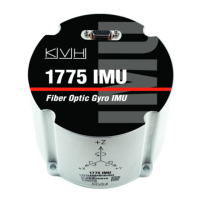This document contains proprietary information of KVH Industries, Inc. and neither this document nor said proprietary information shall be
published, reproduced, copied, disclosed, or used for any purpose without the express written permission of a duly authorized KVH representative.
Page 67 of 77
12.2 Description of Processing Diagram
12.2.1 Sample Data from Sensor Sub-systems
The gyro and accelerometer sub-systems supply data to the ICB at different rates, but the
data processing is similar. In the diagram above, the gyro data from three axes (X, Y, and Z)
is being processed by a sub-system and sent to the ICB internally at 20 KHz. The sub-system
process details are not shown, but do include rotation rate calculation and processing at much
higher rates than 20 KHz. After processing and calibration by the sub-system, it is driven to
the ICB for preparation for output. The accelerometer data from three axes (X, Y, and Z) is
sampled at 8.3125 KHz and sent to the ICB for further processing. Both of these are shown
on the left side of Figure 12-1 as serial bit streams from the gyro and accelerometer sub-
systems flowing into data containers at their sample rates. As this data is updated in the ICB,
an interrupt-driven process will verify the data, add a timestamp, and then notify other
software processes with semaphore flags.
In the case of the gyro data, the values have already been calibrated for bias, scale factor, and
linearity versus temperature by the gyro sub-system. The ICB applies any user- configured
change in axes rotation and any other calibration factors (not shown) as needed. For the
accelerometer data, the ICB performs the temperature calibration needed and then applies
user axes rotation.
12.2.2 Intermediate Stage Processing
Because the final output sample rate to the user is much slower than the internal input
sample rates from the sub-systems, data for gyros and accelerometers must be
downsampled internally. The associated anti-alias filtering is automatically adjusted based on
the ratios of the expected output rate to the internal rates. Note the term “expected,” since for
external MSYNC-controlled output, the actual output rate is not known. However, for
internally timed output, the data rate is configured by command and the output rate is known.
Decimation, filtering followed by downsampling, in the ICB has an intermediate stage and a
final stage. The final stage can be disabled by command (=FILTEN,0) and it can be
configured by command (=FILTTYPE) to be either a pre-defined or semi-custom Chebyshev
or Butterworth type, a custom filter, or to use as a Uniform Averager function. The
intermediate stage filter is always enabled, but its low-pass filter cutoff frequency and
downsampling rate, shown in the diagram as ↓M, are determined by the set data rate.

